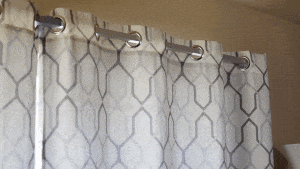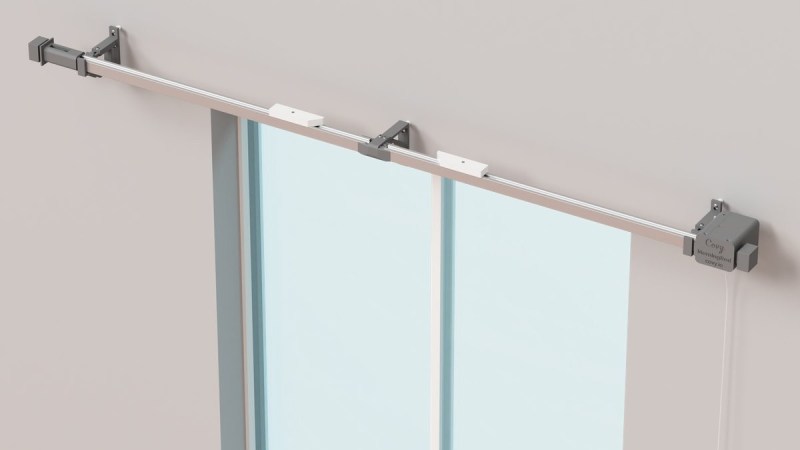Curtains are about as simple as household devices get, but they can be remarkably troublesome to automate. Everyone’s window treatments are slightly different, which frustrates a standardized solution. [dfrenkel] has a passion for DIY and wanted his mornings flooded with sunlight for more peaceful awakenings, so the MorningRod Smart Curtain Rod was born.

MorningRod’s design takes advantage of affordable hardware like aluminum extrusions and 3D printed parts to create a system that attempts to allow users to keep their existing curtains as much as possible.
The curtain rod is replaced with aluminum extrusion. MorningRod borrows ideas from CNC projects to turn the curtain rod into a kind of double-ended linear actuator, upon which the curtains are just along for the ride. An ESP32 serves as the brains while a NEMA17 stepper motor provides the brawn. The result is a motorized curtain opening and closing with a wireless interface that can be easily integrated into home automation projects.
[dfrenkel] is offering a kit, but those who would prefer to roll their own should check out the project page on Thingiverse.
















How about a C channel, then a printed or manufactured threaded rod. Left hand thread for half, right hand tread for the rest. Two simple cars ride the threads and pull the curtain.
Even simpler, a C-channel with a single loop of string in it. Motor one end and idler the other. The carriages are attached to opposite sides of the loop and travel in opposite directions.
Maybe GT2 timing belt instead of string?
Maybe use a GT2 timing belt with a stepper motor. Then run it through some extrusions to make it look nice and hide everything. Oh wait…
Even simplier grab a manual one off the shelf and add a motor. Google for AM43 blind motor (which will do curtains too).
Then it’s “not a hack” and the circle is complete :o)
I have DIY automated blinds and curtains at home. The blinds are off the shelf with a worm geared motor fitted.
The curtains are off the shelf manual cord with the same worm motor.
Funnily enough most commercial solutions which are new on the block use that same type of motor you’ll find all over ebay at different RPM’s and torques.
Both work with simple run timers tho I’d like to add position feedback one day.
Most commercial ones seem to do position based on run time.
Can we get a slow clap for the person that wrote this headline? Kudos!
Yeap … I thought it was related to something else …
Amen to that. I had a sensible chuckle.
Interesting project. I would suggest that you add MQTT support code so it can be controller from a Home Automation system without going through the cloud. There are MQTT drivers for the ESP8266 so I assume that there are ones that can be used on the ESP32.
I always worry about devices that can’t be locally configured and require cloud services. What happens if the cloud services go away.
We almost have it working on ESPHome and Home Assistant. Should be ready in a few days
oooh…. that sort of morning rod….
Morningrod? Good grief. Not useful if your day starts before Sunrise. An automatic blinds control that is.
I leave before sunrise. This would be great for me. In summer it could close the curtains for the day and in winter it could open them. Then my climate control bill would be significantly lower due to passive solar improvements. Add in some inside and outside thermal sensors, and a solar sensor, and some similar controls to open/close windows, and AI to figure out when the most effective times to do all this are, and I’d hardly ever pay for heating or cooling.
This Daniel, I’m the one who built this. This is exactly what I do in my bedroom. They automatically close at 9am and since my window is south facing, I use thermal blinds that lower the room temp by about 10 degrees F. It works very well
Why the initial pause in the video as they retract?
Motor stall detected ?
Because the carriage is moving between the 2 grommets on the back. So there’s a delay from the time is moves from grommet 1 to grommet 2, which then pushes the curtain
Subscribed! …. oh… wait… that doesn’t work here.
Needed this 20 yrs ago and hacked it with blinds black on one side and reflective other. The results were still as expensive as commercially available units and just as failure prone as commercial. Made for a goodly energy savings summer and winter but a constant maintenance problem. When operated manually they work good but the operator tends to fail or is not present.
Thank you for your efforts.
lol. penis jokes.
Can this be done with the track open-side down, so it doesn’t collect dust/dirt that could wear or interfere later?
Perhaps the carriages could encompass the rod.
Or an enclosed rod, with a magnet moving along inside with a matching magnet on the carriage. This would also allow them to separate if a curtain got caught on something?